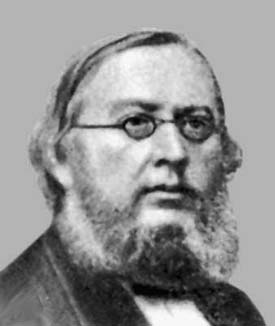
Osip Ivanovich Somov
 المؤلف:
T R Nikiforova
المؤلف:
T R Nikiforova
 المصدر:
Osip Ivanovich Somov
المصدر:
Osip Ivanovich Somov
 الجزء والصفحة:
...
الجزء والصفحة:
...
 5-11-2016
5-11-2016
 1254
1254
Born: 1 June 1815 in Otrada, Moscow gubernia (now oblast), Russia
Died: 26 April 1876 in St Petersburg, Russia

Osip Somov's father was Ivan Somov. Osip attended secondary school in Moscow and then entered Moscow University to study mathematics and physics in the famous Faculty of Physics and Mathematics. He graduated in 1835 and continued to work on his Master's thesis (essentially equivalent to a doctorate). During this time he wrote his first mathematical work on algebraic equations Theory of determinate algebraic equations of higher degree which was published in 1838 [1]. In this paper he demonstrated:-
... not only deep knowledge but also extraordinary skill in presenting the newest achievements of algebraic analysis.
From 1839 he taught at Moscow Commercial College. In 1841 Somov was invited to teach at the University of St Petersburg, and he accepted this invitation and spent the rest of his life living in St Petersburg. With advice from Nikolai Brashman, he continued to work towards his doctorate which was essentially equivalent to the German habilitation in that it provided the route to a professorship. After the award of his doctorate, he was appointed professor of applied mathematics at the University of St Petersburg where he continued to work for the next 25 years. Somov was elected as an associate of the St Petersburg Academy of Sciences in 1857, becoming an academician in 1862 on the death of Mikhail Ostrogradski.
Somov was the first in Russia to develop a geometrical approach to theoretical mechanics. He studied the rotation of a solid body about a point, studying examples arising from the work of Euler, Poinsot, Lagrange and Poisson. Other topics Somov studied included elliptic functions and their application to mechanics. Grigorian writes in [1]:-
Turning his attention to problems of theoretical mechanics, Somov applied results obtained in analytical mechanics to specifically geometric problems. He is rightfully considered the originator of the geometrical trend in theoretical mechanics in Russia during the second half of the nineteenth century. In the theory of elliptical functions and their application to mechanics, he completed the solution of the problem concerning the rotation of a solid body around an immobile point in the Euler-Poinsot and Lagrange-Poisson examples.
The first in Russia to deal with the solution of kinematic problems, Somov included a chapter on this topic in his textbook on theoretical mechanics. His other kinematic works include studies of a point in curvilinear coordinates. Somov's theory of higher-order accelerations of a point, and of an unchanging system of points, was a significant contribution. His works were the first special studies in Russia of nth -order accelerations of both absolute and relative motions of points. His studies of small oscillations of a system around the position of equilibrium are also important.
Among his works (all written in Russian) were Analytic theory of the undulatory motion of the ether (1847), Foundations of the theory of elliptical functions (1850), Course in differential calculus (1852), Analytic geometry (1857), Elementary algebra (1860), Descriptive geometry (1862) and the two volume treatiseRational mechanics (1872-74).
Somov had a son Pavel Osipovich Somov who was born in 1852 and who went on to become a famous mathematician. Pavel Somov created the Russian school of the theory of mechanics of machines. He was the author of important works in the field of theoretical mechanics, theory of hinged mechanisms, synthesis of mechanisms, and screw and vectorial calculus.
- A T Grigorian, Biography in Dictionary of Scientific Biography (New York 1970-1990).
http://www.encyclopedia.com/doc/1G2-2830904082.html
Books:
- T R Nikiforova, Osip Ivanovich Somov (Moscow-Leningrad, 1964).
Articles:
- Y L Geronimus, Osip Ivanovich Somov, in Essays on the works of leading Russian mechanists (Russian) (Moscow, 1952), 58-96.
 الاكثر قراءة في 1800to1819
الاكثر قراءة في 1800to1819
 اخر الاخبار
اخر الاخبار
اخبار العتبة العباسية المقدسة


